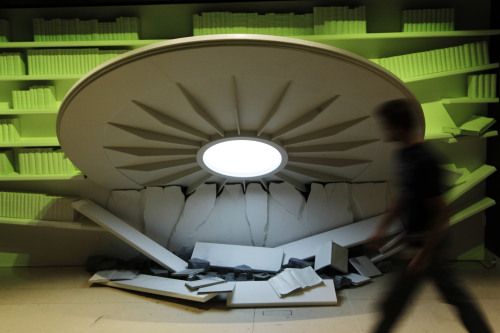LONDON (AP) ― The genre that brought us “The Matrix” has roots reaching back nearly two millennia. The literary tradition often associated with “Star Trek”-loving fanboys has a militant feminist streak. Oh, and science fiction also invented cyberspace.
The British Library’s new exhibit, “Out of this World,” wants visitors to know that there’s more to sci-fi than “The War of the Worlds” or “20,000 Leagues Under the Sea.”
The British Library’s new exhibit, “Out of this World,” wants visitors to know that there’s more to sci-fi than “The War of the Worlds” or “20,000 Leagues Under the Sea.”

“It’s much, much wider than that,” Katya Rogatchevskaia, one of the exhibit’s co-curators, said Thursday. “H.G. Wells and Jules Verne, they are fantastic influences, but it’s a very diverse genre.”
Sometimes thought of as a child of the Industrial Revolution, sci-fi has a lengthy pedigree. One manuscript recapped the second-century account of Lucian of Samosata, who described adventurers being whipped into the air by a whirlwind and dropped onto the surface of the Moon, while the 17th century book depicts what must surely be among the most unusual forms of interplanetary exploration ever devised ― the illustration shows the hero being pulled into space by a flock of swans.
The British Library has plenty of nods to sci-fi stalwarts: One of the exhibition’s props is a saucer crashing into a bookshelf, another is a seven-meter-tall “War of the Worlds”-style metallic tripod, while “Dr. Who” fans will be delighted to see a replica of the time-traveling alien’s iconic blue police box. A small model of the “Back to the Future” DeLorean also makes an appearance, in a section of the exhibition devoted to the paradoxes of time travel.
There’s a good helping of the obligatory pulp ― “action-packed” books whose covers feature busty damsels being pursued by slimy beings. But there’s a host of more obscure material too, such as 1914 postcards imagining a futuristic Moscow dominated by massive airships and soaring aerial tramways or a British satirical piece from the 1820s that features a massive vacuum tube sucking people and merchandise “direct to Bengal.”
Also covered are the works of author William Gibson, who coined the term “cyberspace” and supplied the Internet age with much of its iconography (he’s also credited with developing some of the ideas for “The Matrix” trilogy).
Gibson’s “Neuromancer” is considered a classic, but there are classics and then there are classics. The British Library’s star attraction was Thomas Moore’s “Utopia,” which invented the word and gave Moore’s 16th century contemporaries a vision of a stable, idealized island to compare to the unsettled politics of their own day.
The exhibit is full of Moore’s imitators. Communist writer Alexander Bogdanov built his Marxist utopia on Mars ― the red planet. American Edward Bellamy imagined a future of full employment and retirement at 45.
Dystopias abound too. Soviet writer Yevgeny Zamyatin’s 1920 work “My” describes a society so severely regimented that officials decided when its citizens have sex. The U.S.S.R. banned the work, but it was published clandestinely and helped inspire George Orwell’s “1984,” whose sinister image of an all-seeing Big Brother still informs contemporary debates over surveillance and control.
Co-curator Andy Sawyer said that the genre worked best in what he called its “metaphoric role,” when the sci-fi setting serves as a mirror to our own.
The number of issues science fiction can tackle are potentially endless: George Schuyler’s “Black No More” uses the imagined discovery of a skin-whitening therapy to lampoon the racial attitudes of 1930s America; The pollution-drenched and weather-wrecked planet depicted in 1972’s “The Sheep Look Up” served as a comment on U.S. attitudes toward ecological issues.
”The Sultana’s Dream,” a 1905 work by Bengali social reformer Roquia Sakhwat Hussain, imagined a world of flying cars and solar energy where men were locked away in a kind of reverse purdah ― a critique of her culture’s restrictive sexual mores.
Easily the most fun is “Only Lovers Left Alive,” a book which posits the mass suicide of all adults ― leaving the teens to go on a hormonal rampage. The work drips with 1960s generation-gap anxiety.
”It doesn’t need to imitate our world or even look like our world,” said Sawyer. “(But) science fiction works best when it’s about our world.”










![[Kim Seong-kon] Democracy and the future of South Korea](http://res.heraldm.com/phpwas/restmb_idxmake.php?idx=644&simg=/content/image/2024/04/16/20240416050802_0.jpg&u=)







![[Today’s K-pop] Zico drops snippet of collaboration with Jennie](http://res.heraldm.com/phpwas/restmb_idxmake.php?idx=642&simg=/content/image/2024/04/18/20240418050702_0.jpg&u=)